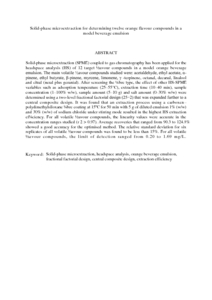Citation
Mirhosseini, Seyed Hamed and Tan, Chin Ping and Yusof, Salmah and Sheikh Abdul Hamid, Nazimah
(2008)
Solid-phase microextraction for determining twelve orange flavour compounds in a model beverage emulsion.
Phytochemical Analysis, 19 (5).
pp. 429-437.
ISSN 0958-0344
Abstract
Solid-phase microextraction (SPME) coupled to gas chromatography has been applied for the headspace analysis (HS) of
12 target ½avour compounds in a model orange beverage emulsion. The main volatile ½avour compounds studied were: acetaldehyde,
ethyl acetate, α-pinene, ethyl butyrate, β-pinene, myrcene, limonene, γ -terpinene, octanal, decanal, linalool and citral (neral
plus geranial). After screening the ¼bre type, the effect of other HS-SPME variables such as adsorption temperature (25–55°C),
extraction time (10–40 min), sample concentration (1–100% w/w), sample amount (5–10 g) and salt amount (0–30% w/w) were
determined using a two-level fractional factorial design (25−2) that was expanded further to a central composite design. It was found
that an extraction process using a carboxen–polydimethylsiloxane ¼bre coating at 15ºC for 50 min with 5 g of diluted emulsion 1%
(w/w) and 30% (w/w) of sodium chloride under stirring mode resulted in the highest HS extraction ef¼ciency. For all volatile
½avour compounds, the linearity values were accurate in the concentration ranges studied (r 2 > 0.97). Average recoveries that
ranged from 90.3 to 124.8% showed a good accuracy for the optimised method. The relative standard deviation for six replicates of
all volatile ½avour compounds was found to be less than 15%. For all volatile ½avour compounds, the limit of detection ranged from
0.20 to 1.69 mg/L.
Download File
![[img]](http://psasir.upm.edu.my/7393/1.hassmallThumbnailVersion/Solid-phase%20microextraction%20for%20determining%20twelve%20orange%20flavour%20compounds%20in%20a%20model%20beverage%20emulsion.pdf)  Preview |
|
PDF (Abstract)
Solid-phase microextraction for determining twelve orange flavour compounds in a model beverage emulsion.pdf
Download (186kB)
| Preview
|
|
Additional Metadata
Actions (login required)
 |
View Item |

